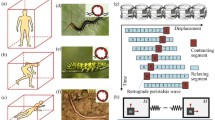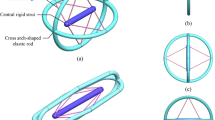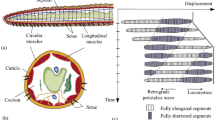Abstract
The earthworm-like robot is designed for prospective applications such as disaster rescue and pipeline detection in natural environments. However, current studies on the interaction modeling between the earthworm-like robot and the environment only consider rigid contact. This simplification limits the reliability of dynamic analysis and locomotion optimization on soft surfaces, such as sand. Therefore, developing a method for refined contact modeling for the earthworm-like robot and describing the contact effect induced by the soft environmental medium is urgent. To this end, this paper proposes a new modeling architecture called the elementary mechanical network (EMN). EMN is constructed as fractal structures for the convenience of network reconfiguration. First, elementary mechanical elements, such as the damper, spring, and slider, are parallelly connected to constitute a basic module. Second, the modules are serially linked to create a group. Finally, the groups are parallelly assembled to form the network. EMN is also proven to be equivalent to recurrent neural networks in specific forms. Therefore, EMN inherits the advantages of physical interpretability from mechanical elements and universal approximability from conventional networks. In addition, particle swarm optimization and Boolean operation are employed for network weight training and topological minimization. Numerical examples show that using EMNs with identical initial structures can accurately describe diverse empirical models in the minimum realization. EMN is applied for contact modeling for the earthworm-like locomotion robot in the dry sand based on such versatility. The experiment measures the normal and tangential ground reaction forces with different sinkage depths and locomotion speeds. Trained results reveal a common law that the contact effect in the dry sand is similar to Coulomb friction. The proposed EMN does not require prior system knowledge and promises a minimal physical representation, thus encouraging a successful exploration of constitutive modeling in broad scopes.
Similar content being viewed by others
References
Picardi G, Chellapurath M, Iacoponi S, et al. Bioinspired underwater legged robot for seabed exploration with low environmental disturbance. Sci Robot, 2020, 5: 1–15
Raibert M, Blankespoor K, Nelson G, et al. BigDog, the rough-terrain quadruped robot. IFAC Proc Volumes, 2008, 41: 10822–10825
Hirose S, Fukushima E F. Snakes and strings: New robotic components for rescue operations. Int J Robot Res, 2004, 23: 341–349
Gao J, Gao X, Zhu W, et al. Design and research of a new structure rescue snake robot with all body drive system. In: 2008 IEEE International Conference on Mechatronics and Automation. Takamatsu, 2008. 119–124
Yamashita A, Matsui K, Kawanishi R, et al. Self-localization and 3-D model construction of pipe by earthworm robot equipped with omnidirectional rangefinder. In: 2011 IEEE International Conference on Robotics and Biomimetics. Karon Beach, 2011. 1017–1023
Tang Z, Lu J, Wang Z, et al. Development of a new multi-cavity pneumatic-driven earthworm-like soft robot. Robotica, 2020, 38: 2290–2304
Tang L, Zhu L M, Zhu X Y, et al. Confined spaces path following for cable-driven snake robots with prediction lookup and interpolation algorithms. Sci China Tech Sci, 2020, 63: 255–264
Gao J, Yan G. Locomotion analysis of an inchworm-like capsule robot in the intestinal tract. IEEE Trans Biomed Eng, 2016, 63: 300–310
Gao J Y, Yan G Z, Shi Y B, et al. Optimization design of extensor for improving locomotion efficiency of inchworm-like capsule robot. Sci China Tech Sci, 2019, 62: 1930–1938
Zhan X, Fang H, Xu J, et al. Planar locomotion of earthworm-like metameric robots. Int J Robot Res, 2019, 38: 1751–1774
Fang H, Li S, Wang K W, et al. A comprehensive study on the locomotion characteristics of a metameric earthworm-like robot. Multibody Syst Dyn, 2015, 34: 391–413
Cao Z, Zhang D, Zhou M C. Modeling and control of hybrid 3-D gaits of snake-like robots. IEEE Trans Neural Netw Learn Syst, 2021, 32: 4603–4612
Zhang D, Yuan H, Cao Z. Environmental adaptive control of a snake-like robot with variable stiffness actuators. IEEE CAA J Autom Sin, 2020, 7: 745–751
Fang H, Wang C, Li S, et al. A comprehensive study on the locomotion characteristics of a metameric earthworm-like robot. Multibody Syst Dyn, 2015, 35: 153–177
Urbaś A. Application of the dahl friction model in the dynamics analysisof grab cranes. In: CSNDD 2016-International Conference on Structural Nonlinear Dynamics and Diagnosis. Marrakech, 2016
Simoni L, Beschi M, Visioli A, et al. Inclusion of the dwell time effect in the LuGre friction model. Mechatronics, 2020, 66: 102345
Liu Y J, Li T, Sun L N. Design of a control system for a macro-micro dual-drive high acceleration high precision positioning stage for IC packaging. Sci China Ser E-Technol Sci, 2009, 52: 1858–1865
Sun H X, Wang X Y, Chen Z Q. Parameter identification of LuGre model with improved genetic algorithms (in Chinese). J Wuhan Univ Technol, 2009, 31: 113–117
Rizos D D, Fassois S D. Friction identification based upon the LuGre and maxwell slip models. IEEE Trans Contr Syst Technol, 2009, 17: 153–160
Gehb C M, Atamturktur S, Platz R, et al. Bayesian inference based parameter calibration of the LuGre-friction model. Exp Tech, 2020, 44: 369–382
Shen T, Dong Y L, He D X, et al. Online identification of time-varying dynamical systems for industrial robots based on sparse Bayesian learning. Sci China Tech Sci, 2022, 65: 386–395
Li C Y, Li Z Q, Jiang Z N, et al. Autonomous planning and control strategy for space manipulators with dynamics uncertainty based on learning from demonstrations. Sci China Tech Sci, 2021, 64: 2662–2675
Iagnemma K, Shibly H, Dubowsky S. On-line terrain parameter estimation for planetary rovers. In: Proceedings 2002 IEEE International Conference on Robotics and Automation. Washington, 2002, 3. 3142–3147
Leite A C, Gallina A, Schäfer B. Parameter identification and contact modeling for planetary wheeled rovers in soft soil. IFAC Proc Volumes, 2012, 45: 1707–1712
Ding L, Gao H, Deng Z, et al. Foot-terrain interaction mechanics for legged robots: Modeling and experimental validation. Int J Robot Res, 2013, 32: 1585–1606
Ding L, Gao H B, Deng Z Q, et al. Three-Layer Intelligence of Planetary Exploration Wheeled Mobile Robots: Robint, Virtint, and Humint. Sci China Technol Sci, 2015, 58: 1299–1317
Yao D, Yang L, Xiao X, et al. Velocity-based gait planning for underactuated bipedal robot on uneven and compliant terrain. IEEE Trans Ind Electron, 2022, doi: https://doi.org/10.1109/TIE.2021.3125671
Xue L, Li J, Zou M, et al. In situ identification of shearing parameters for loose lunar soil using least squares support vector machine. Aerosp Sci Technol, 2016, 53: 154–161
Taghavifar H, Mardani A. Wavelet neural network applied for prognostication of contact pressure between soil and driving wheel. Inf Process Agr, 2014, 1: 51–56
Pan Y, Li Y, Ma P, et al. New approach of friction model and identification for hydraulic system based on MAPSO-NMDS Optimization elman neural network. Adv Mech Eng, 2017, 9: 168781401774447
Song X, Gao H, Ding L, et al. Locally supervised neural networks for approximating terramechanics models. Mech Syst Signal Process, 2016, 75: 57–74
Ismail A, Jeng D S, Zhang L L. An optimised product-unit neural network with a novel PSO-BP hybrid training algorithm: Applications to load-deformation analysis of axially loaded piles. Eng Appl Artif Intell, 2013, 26: 2305–2314
Liu Q, Liang J, Ma O. A physics-based and data-driven hybrid modeling method for accurately simulating complex contact phenomenon. Multibody Syst Dyn, 2020, 50: 97–117
Jiang M, Shen Z, Thornton C. Microscopic contact model of lunar regolith for high efficiency discrete element analyses. Comput Geotech, 2013, 54: 104–116
Bordbar M H, Hyppänen T. Modeling of binary collision between multisize viscoelastic spheres. J Numer Anal Ind Appl Math, 2007, 2: 115–128
Zhang S Z, Zhang X W. A comparative study of different online model parameters identification methods for lithium-ion battery. Sci China Tech Sci, 2021, 64: 2312–2327
Wang J J, Kumbasar T. Optimal PID control of spatial inverted pendulum with big bang-big crunch optimization. IEEE CAA J Autom Sin, 2020, 7: 822–832
Wang J, Kumbasar T. Parameter optimization of interval Type-2 fuzzy neural networks based on PSO and BBBC methods. IEEE CAA J Autom Sin, 2019, 6: 247–257
Gao S, Zhou M, Wang Y, et al. Dendritic neuron model with effective learning algorithms for classification, approximation, and prediction. IEEE Trans Neural Netw Learn Syst, 2019, 30: 601–614
Zhang W J, Qin J, Mei F, et al. Short-term power load forecasting using integrated methods based on long short-term memory. Sci China Technol Sci, 2020, 63: 614–624
Luo X, Zhou Y, Liu Z, et al. Generalized Nesterov’s acceleration-incorporated non-negative and adaptive latent factor analysis. IEEE Trans Serv Comput, 2021, doi: https://doi.org/10.1109/TSC.2021.3069108
Lin H, Zhao B, Liu D, et al. Data-based fault tolerant control for affine nonlinear systems through particle swarm optimized neural networks. IEEE CAA J Autom Sin, 2020, 7: 954–964
Roy P, Mahapatra G S, Dey K N. Forecasting of software reliability using neighborhood fuzzy particle swarm optimization based novel neural network. IEEE CAA J Autom Sin, 2019, 6: 1365–1383
Chen J, Luo X, Zhou M. Hierarchical particle swarm optimization-incorporated latent factor analysis for large-scale incomplete matrices. IEEE Trans Big Data, 2021, doi: https://doi.org/10.1109/TBDATA.2021.3090905
Iurian C, Ikhouane F, Rodellar Benedé J J et al. Identification of a system with dry fiction. Reports Recer l’Institut d’Organització i Control Sist Ind, 2005, 1, https://upcommons.upc.edu/bitstream/handle/2117/511/Iuriam.pdf
Fang H, He Z, Xu J. An earthworm-inspired multi-mode underwater locomotion robot: Design, modeling, and experiments. https://arxiv.org/abs/2108.05518
Fang H, Zhang Y, Wang K W. Origami-based earthworm-like locomotion robots. Bioinspir Biomim, 2017, 12: 065003
Author information
Authors and Affiliations
Corresponding author
Additional information
This work was supported by the National Natural Science Foundation of China (Grant Nos. 11932015 and 11902077), the Shanghai Sailing Program (Grant No. 19YF1403000), and the Science and Technology Commission of Shanghai Municipality (Grant No. 19511132000).
Supporting information
The supporting information is available online at tech.scichina.com and link.springerlink.com. The supporting materials are published as submitted, without typesetting or editing. The responsibility for scientific accuracy and content remains entirely with the authors.
Electronic Supplementary Material
Rights and permissions
About this article
Cite this article
He, K., Zhang, X. Environmental contact modeling for the earthworm-like robot via the novel elementary mechanical network. Sci. China Technol. Sci. 65, 1366–1382 (2022). https://doi.org/10.1007/s11431-021-2016-8
Received:
Accepted:
Published:
Issue Date:
DOI: https://doi.org/10.1007/s11431-021-2016-8




